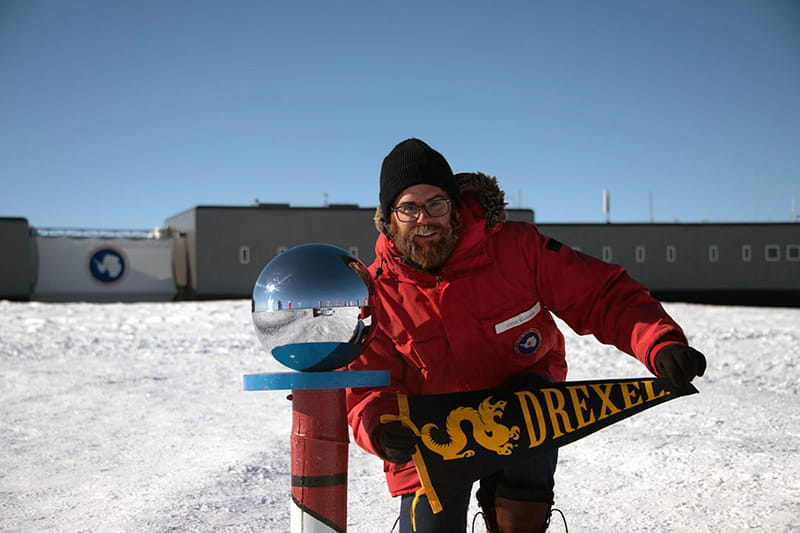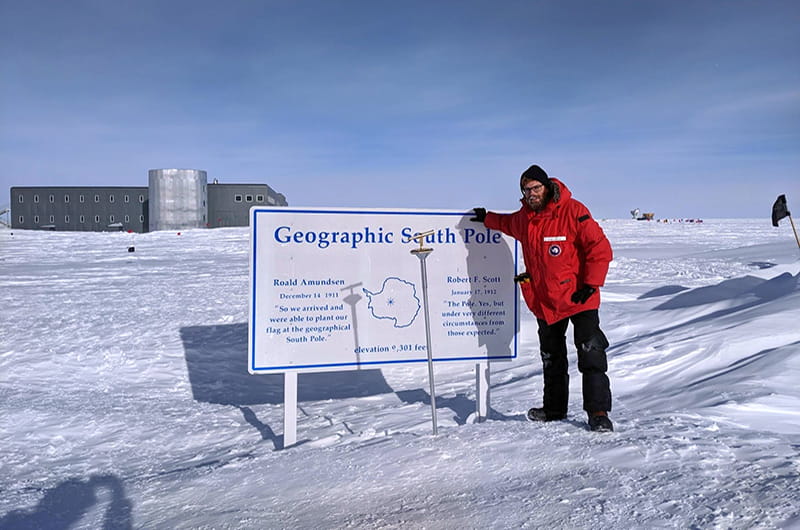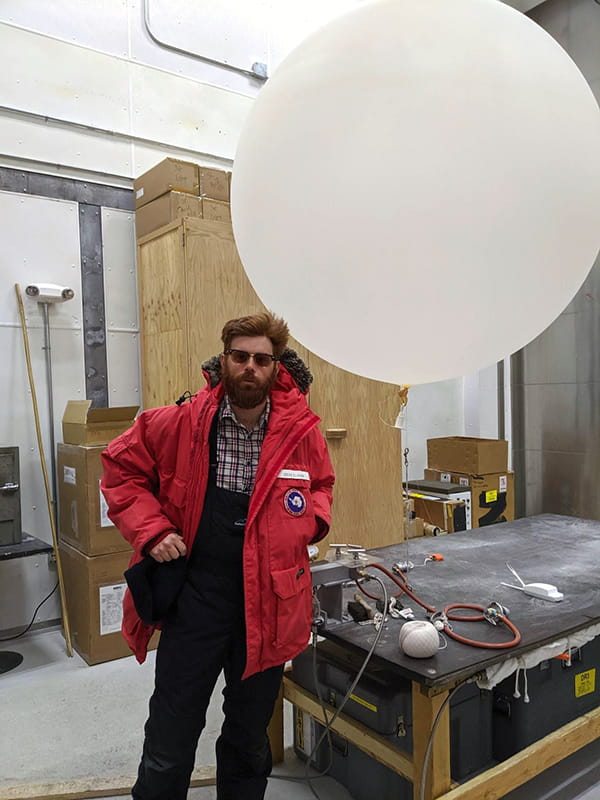A Drexel PhD Student’s 'Summer' at the South Pole

- Drexel Environmental Collaboratory Releases Cross-Sector Findings on Severe Weather Recovery Challenges
- How and When Could AI Be Used in Emergency Medicine?
- Video Game Design Reaches New Heights in 'Skyscraper Games'
- MXene Current Collectors Could Reduce Size, Improve Recyclability of Li-Ion Batteries

Last fall Drexel University PhD student in physics Steve Sclafani had to bring a very important, yet absurd question to the customer service reps at REI: “Where’s the South Pole section?”
Well, OK, he didn’t ask exactly that, but he was on his way to the South Pole and he did need the warmest gloves and socks they had on hand to prepare for the sub-zero temperatures in Antarctica even in their “summer” season.

Sclafani was headed to the IceCube South Pole Neutrino Observatory as a member of the Drexel IceCube Research group, and subsequently the larger IceCube Collaboration. The collaboration includes more than 300 people from 52 institutions (including Drexel) across 12 countries who helped to build, test and continue to maintain the detector. The Drexel research group is led by Naoko Kurahashi Neilson, PhD, an associate professor in the College of Arts and Sciences, who conducted neutrino research at IceCube while she was a postdoctoral researcher at the University of Wisconsin–Madison (the university operates IceCube).
And why exactly do we want to study these high-energy particles called neutrinos, you may ask?
“We know that they're coming from space,” Sclafani said. “We know that they're coming from matter outside of our own galaxy, but we haven't been able to nail down exactly where.”
Neilson was part of a team that discovered that some neutrinos originate from blazars, which are a type of galaxy powered by a gigantic black hole. She outlined her discovery in two papers published in Science in 2018 (one of which Sclafani co-authored). Sclafani is now working on his own research which expands on that of his mentor; he aims to answer the bigger question of where all high-energy neutrinos come from.
But in order to make research like Sclafani and his mentor’s possible, scientists must support and maintain the observatory. While his trip from Nov. 7–Dec. 20 was in a support rather than a research role, Sclafani beat out dozens of other graduate students to earn a spot. Only five to 10 graduate students are invited to the research station each year.
“It was my first year applying and I got to go, so that was awesome and surprising,” he said of the opportunity. “As soon as I joined this project, I knew it was something that I'd like to do.”
Sclafani’s engineering background from his undergraduate years, plus the couple summers he’s spent in Madison gaining familiarity with the hardware work needed to support onsite research at IceCube, helped qualify him for this opportunity.

Neilson said she was “immensely proud” that Sclafani was given the opportunity to “go to Pole,” especially since the selection is tight and based on the quality of work done for the experiment thus far. She added that the scientists of the IceCube Collaboration value the work done maintaining the detector as a crucial part of doing research.
“If we don't maintain the detector, there is no ‘own research’ for us,” she said. “Nobody in our field does research by themselves because nobody can afford a multi-hundred-million-dollar experiment alone.”
And, in some ways, Sclafani was glad he wasn’t there for research.
“When equipment got delayed, [I was thinking] ‘At least it’s not my thesis!’” he explained. “We had a lot of cargo mishaps where it didn't get there in time. So, you know, people had to stay later or miss Christmas with their families and all that. It was nice that I didn't have that kind of pressure.”
Despite this, there are still several stressors associated with life on the South Pole, like slow internet, no cell phones and 24 hours of sunlight. Still, if you want to study neutrinos, this is where you have to be.
“You need a lot of water,” Sclafani explained, as neutrinos give off light when they pass through water (or in this case, ice), which is used to detect them. “We're looking for the highest-energy neutrinos. So you need about a kilometer of water, and that's impossible to build. … You have to find infrastructure that already exists. The South Pole has airfields. It has places for people to live. It has food and cargo and fuel and all these things that you need to sustain a base to run an experiment.”

Despite all this, Sclafani knows that living on the South Pole for over a month was a once-in-a-lifetime opportunity — one that tourists spend a lot of money on just to experience for one night. So he didn’t take his time for granted. He took lots of pictures and didn’t let the cold get to him.
“Honestly, it's surprising how quickly you get used to it,” he said. “It's cold. It’s colder than here. But [they provide] clothes that are the best in the world. So, if you go outside, you're not freezing.”
And maybe, before his time at Drexel is over, Sclafani will be able to return to IceCube in a support role, or even as part of his thesis research.
“I do hope he gets to go again in the future if he wishes,” Neilson said. “[Sclafani] will be a successful scientist for years to come and if he wishes to be involved in experiments at the Pole in the future, I'm sure there will be a way.”
“The fact that I've been to the South Pole, that I got to go down there, that this was part of my grad student research, is pretty amazing,” Sclafani said. “With grad school, you're not doing it for the money. It’s long hours, tough work for very little pay. And so, the experiences, if you get them, are part of the reward.”
“I can really tell people, ‘Alright, I still haven’t been to all seven continents, but I got the hard one down,’” he continued. “I've been to a place where, comparatively, a fraction of a fraction of a percentage of the population have been.”
In This Article
Drexel News is produced by
University Marketing and Communications.